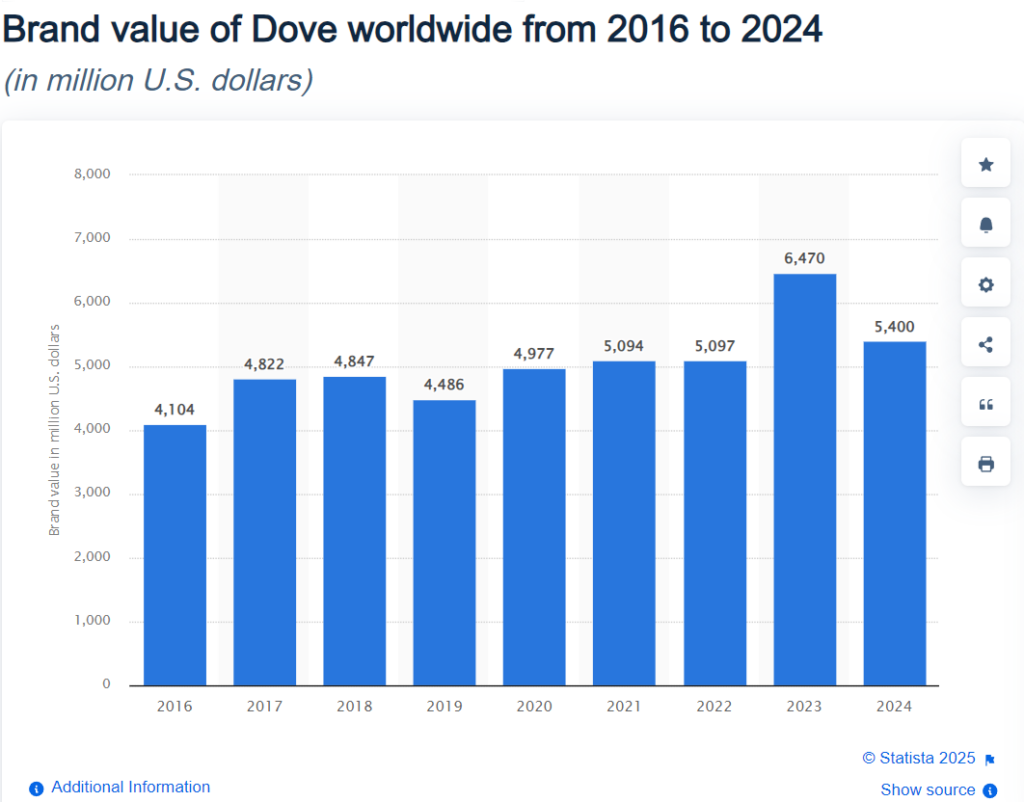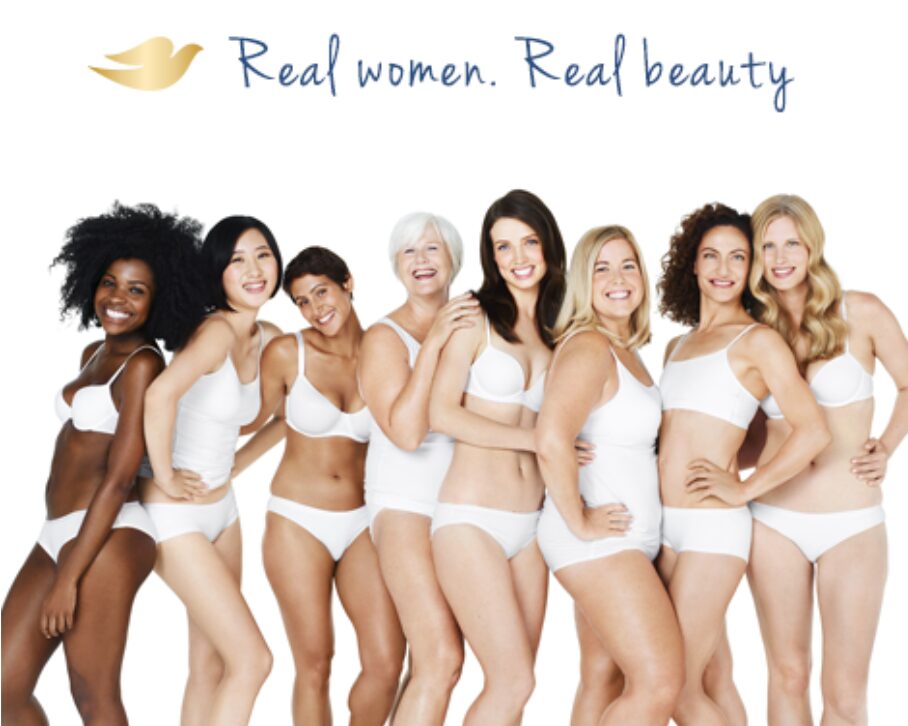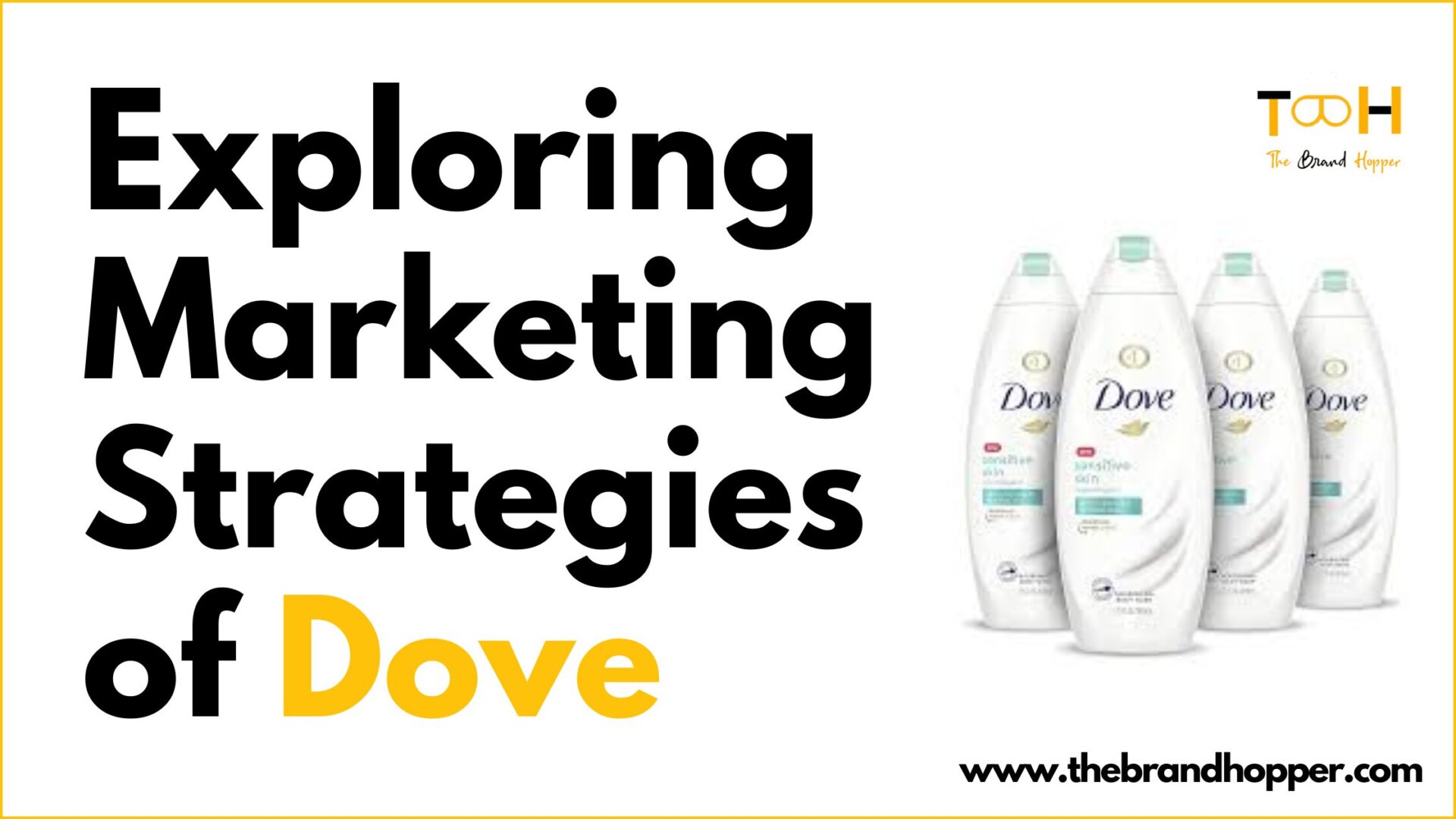Dove, a flagship brand of Unilever, has become a global symbol of beauty, confidence, and self-care since its inception in 1957. Originally introduced as a revolutionary beauty bar with moisturizing properties, Dove has evolved into a multibillion-dollar brand spanning personal care categories, including skincare, haircare, and deodorants. Known for its commitment to redefining beauty standards, Dove stands out as a pioneer in promoting body positivity, inclusivity, and self-acceptance.

Dove’s journey began in the United States, where it launched its iconic Beauty Bar. Unlike traditional soaps, this bar was formulated with one-quarter moisturizing cream, making it gentle and non-drying for the skin. This unique proposition differentiated Dove in a competitive market, instantly resonating with consumers who sought effective yet skin-friendly cleansing solutions. Over the years, the brand expanded its product offerings, moving into body washes, shampoos, conditioners, lotions, and antiperspirants.
A cornerstone of Dove’s success is its purpose-driven marketing. In 2004, the brand launched the Dove Campaign for Real Beauty, which challenged traditional beauty ideals by showcasing women of all shapes, sizes, ages, and ethnicities. The campaign aimed to foster a global conversation about self-esteem and body image, marking a shift from conventional advertising that often relied on unattainable beauty standards. The campaign’s authenticity struck a chord with consumers, earning Dove widespread acclaim and solidifying its reputation as a brand that champions real beauty.

Also Read: Case Study: Dove’s “Real Beauty” Brand Campaign
Dove’s parent company, Unilever, played a pivotal role in its growth. As one of the largest consumer goods companies in the world, Unilever leveraged its extensive research and development capabilities, global distribution networks, and marketing expertise to position Dove as a trusted name in personal care. Unilever’s commitment to sustainability also aligns seamlessly with Dove’s mission to promote ethical practices, further strengthening the brand’s appeal among conscious consumers.
One of the unique aspects of Dove is its emphasis on empowering women and promoting self-esteem. The brand’s Self-Esteem Project, launched in 2004, aims to educate young people about body confidence and provide tools to build self-esteem. To date, this initiative has reached over 82 million young people in 150 countries, demonstrating Dove’s dedication to making a tangible social impact.
Dove’s product philosophy centers around efficacy and care. The brand invests heavily in research to create products that deliver on their promises. For instance, its Advanced Care antiperspirants and Pro-Age skincare lines address specific consumer needs, from sensitive skin to anti-aging solutions. This focus on innovation ensures Dove remains relevant in a constantly evolving market.
The brand’s global presence is another testament to its success. Dove operates in over 150 countries, adapting its products and messaging to cater to local markets. In India, for example, Dove emphasizes nourishment and care for dry, damaged hair, reflecting regional concerns about heat and pollution. Similarly, in African markets, Dove highlights its products’ ability to provide hydration and protect against harsh environmental conditions.
Sustainability is at the heart of Dove’s operations. The brand has made significant strides toward reducing its environmental footprint, from using 100% recycled plastic bottles to eliminating unnecessary plastic packaging. Dove is also part of Unilever’s Clean Future initiative, which aims to replace fossil fuel-derived ingredients with renewable alternatives in its products. These efforts underscore Dove’s commitment to protecting the planet while providing high-quality products to its consumers.
In recent years, Dove has embraced digital transformation to enhance its reach and engagement. The brand leverages social media, influencer collaborations, and content marketing to connect with its audience, particularly younger consumers. Campaigns like #ShowUs and #MyHairMyCrown amplify Dove’s message of inclusivity and self-love, while user-generated content fosters deeper connections with its audience.
Despite its success, Dove is not without challenges. The brand has faced criticism for perceived inconsistencies in its messaging, particularly when juxtaposed with other Unilever brands that adhere to more traditional beauty standards. However, Dove has taken these critiques as opportunities for growth, reinforcing its commitment to authenticity and transparency.
In conclusion, Dove is much more than a personal care brand; it is a cultural phenomenon that has reshaped how the world perceives beauty. Through its innovative products, purpose-driven campaigns, and dedication to sustainability, Dove has set a new standard in the beauty industry. By championing real beauty, inclusivity, and self-confidence, Dove continues to inspire millions worldwide, solidifying its legacy as a brand that truly cares.
Marketing Strategies of Dove
Dove has built a distinctive identity through purpose-driven marketing, innovative product development, and an unwavering commitment to inclusivity. Its success lies in its ability to connect emotionally with consumers while delivering products that align with their values and needs. Below are the detailed marketing strategies that have shaped Dove into a globally recognized and trusted brand.
1. Purpose-Driven Marketing: The Campaign for Real Beauty
Launched in 2004, the Dove Campaign for Real Beauty marked a paradigm shift in beauty advertising. Unlike traditional campaigns that glorified unattainable beauty standards, Dove celebrated real women of diverse shapes, sizes, ethnicities, and ages.
- Objective: To challenge societal beauty stereotypes and create a more inclusive definition of beauty.
- Execution: Campaign visuals and advertisements featured unretouched photos of everyday women, accompanied by empowering messaging.
- Impact: The campaign resonated globally, earning widespread acclaim and awards, including the Grand Prix at Cannes Lions. It also solidified Dove as a brand that champions authenticity and self-confidence.
This strategy set Dove apart from competitors, fostering an emotional connection with its audience and positioning it as a socially responsible brand.
2. Focus on Emotional Storytelling
Dove’s advertisements and digital campaigns use emotional storytelling to connect with consumers on a deeper level. Campaigns like “Real Beauty Sketches” and “Choose Beautiful” showcase women grappling with self-perception, ultimately empowering them to embrace their individuality.
- “Real Beauty Sketches” (2013): Highlighted the disparity between how women view themselves versus how others perceive them. The campaign went viral, garnering over 114 million views in its first month.
- “Choose Beautiful” (2015): Encouraged women to redefine beauty and make choices that affirm their self-worth.
This storytelling approach not only drives engagement but also reinforces Dove’s mission to promote self-esteem and body positivity.
3. Self-Esteem Project: Building Social Impact
Dove launched its Self-Esteem Project in 2004 to tackle low self-esteem and body image issues among young people. The project provides educational resources, workshops, and digital content to help individuals build confidence.
- Global Reach: The project has impacted over 82 million young people in 150 countries.
- Partnerships: Collaborated with organizations like Girl Scouts of the USA and Plan International to expand its influence.
- Reinforcement of Brand Values: This initiative demonstrates Dove’s commitment to creating meaningful change, enhancing its reputation as a brand that cares beyond profits.
4. Innovative Product Marketing
Dove’s marketing strategy also emphasizes the unique selling points of its products, such as gentle formulas with moisturizing benefits.
- Positioning: Dove positions itself as a brand offering products that provide both care and effectiveness.
- Product Campaigns: Marketing focuses on functional benefits, like “1/4 moisturizing cream” in its Beauty Bar or damage-repair solutions in its haircare lines.
- Target Audience Expansion: With product ranges catering to men (Dove Men+Care) and babies (Dove Baby), Dove has effectively broadened its consumer base.
This dual focus on functionality and care ensures customer loyalty and repeat purchases.
5. Digital Transformation and Social Media Campaigns
Dove has effectively embraced digital transformation and social media campaigns as a crucial marketing strategy to amplify its brand message and engage with younger audiences. By leveraging platforms like Instagram, Facebook, and TikTok, Dove has created a strong digital presence that resonates with consumers who prioritize authenticity and inclusivity. The brand’s commitment to promoting real beauty is evident in its campaigns, such as the #ShowUs initiative, which encourages women to share their photos and stories. This user-generated content not only fosters a sense of community among real beauty advocates but also empowers women by celebrating their diverse representations. By tapping into user-generated content, Dove strengthens its connection with consumers, making them active participants in the brand’s narrative.
In addition to user-generated content, Dove has strategically partnered with influencers who align with its values to promote products authentically. These collaborations allow the brand to reach niche audiences and enhance its credibility through relatable voices. For example, Dove has worked with influencers who advocate for body positivity and self-acceptance, sharing personal stories that resonate deeply with their followers. This influencer marketing approach not only broadens Dove’s reach but also reinforces its commitment to empowering individuals through authentic narratives that challenge traditional beauty standards. By aligning itself with influencers who embody its core message, Dove effectively engages younger consumers who seek genuine connections with brands.
Moreover, Dove’s use of viral campaigns featuring short videos, testimonials, and live sessions significantly enhances visibility and engagement across digital platforms. Campaigns like the “Courage is Beautiful” initiative spotlight healthcare workers during the pandemic while emphasizing the importance of self-acceptance and inner beauty. These campaigns often go viral due to their emotional resonance and shareability, allowing Dove to maintain relevance in an ever-evolving digital landscape. By leveraging digital tools and innovative content strategies, Dove not only keeps pace with changing consumer behaviors but also solidifies its position as a leader in promoting real beauty in a crowded marketplace. Through these efforts, Dove continues to inspire conversations around beauty standards while fostering a loyal community of advocates for self-esteem and authenticity.
6. Localized Marketing for Global Reach
Dove has effectively implemented localized marketing for global reach as a key strategy, allowing the brand to resonate with diverse audiences while maintaining its core message of real beauty. By tailoring its marketing strategies to address cultural nuances and specific beauty concerns in different regions, Dove ensures that its campaigns are relevant and impactful. For instance, in India, Dove’s campaigns focus on providing nourishment and solutions for hair damaged by pollution and humidity, which are prevalent issues for many consumers in urban areas. This localized approach not only addresses specific consumer needs but also fosters a deeper connection between the brand and its audience.
In Africa, Dove emphasizes hydration and protection from harsh environmental conditions, recognizing the unique challenges faced by consumers in that region. Campaigns often highlight the importance of moisturizing products that cater to the specific climate and skin needs of African consumers. For example, Dove has launched initiatives that showcase local women sharing their beauty routines, which not only promotes the brand’s products but also empowers women by celebrating their natural beauty. By focusing on these localized narratives, Dove effectively engages with consumers on a personal level, reinforcing its commitment to understanding and addressing their unique beauty concerns
While Dove maintains a consistent global message centered around real beauty, its localized campaigns ensure relevance across diverse markets. This strategy is exemplified by the brand’s “Real Beauty” campaign, which has adapted to various cultural contexts while promoting body positivity and self-acceptance. By incorporating local influencers and culturally relevant imagery into its marketing efforts, Dove successfully resonates with consumers worldwide. This blend of global consistency with local relevance not only enhances brand loyalty but also positions Dove as a leader in the beauty industry committed to empowering individuals through authentic representation and understanding of their unique beauty narratives.
7. Commitment to Sustainability and Ethical Practices
Dove has placed sustainability and ethical practices at the forefront of its marketing strategy, aligning its initiatives with Unilever’s Clean Future goals. This commitment is evident in Dove’s transition to 100% recycled plastic bottles, significantly reducing virgin plastic usage in its packaging. The brand has set ambitious targets to further minimize its environmental impact, including a commitment to reduce the use of virgin plastic by over 20,500 tonnes annually. By focusing on eco-friendly packaging, Dove not only addresses growing consumer concerns about plastic waste but also positions itself as a responsible leader in the beauty industry.
Ingredient transparency is another critical aspect of Dove’s commitment to sustainability. The brand emphasizes the use of safe and ethically sourced ingredients, appealing to environmentally conscious consumers who prioritize products that align with their values. For instance, Dove has made strides in ensuring that its formulations are free from harmful chemicals and are cruelty-free, receiving certification from organizations like PETA. This focus on transparency and ethical sourcing enhances consumer trust and loyalty, as customers increasingly seek brands that reflect their personal ethics regarding health and environmental responsibility.
Dove’s marketing strategy also includes impactful campaigns that highlight its dedication to sustainability and social good. The “Courage is Beautiful” campaign stands out as a poignant example, showcasing healthcare workers during the COVID-19 pandemic while reinforcing Dove’s commitment to social causes. This campaign not only celebrated the bravery of frontline workers but also aligned with Dove’s broader mission of promoting self-esteem and body positivity. By integrating sustainability into its core messaging, Dove effectively appeals to a growing demographic of environmentally conscious consumers, demonstrating that true beauty encompasses both personal empowerment and a commitment to caring for the planet.
8. Collaborations and Partnerships
Dove has strategically utilized collaborations and partnerships as a cornerstone of its marketing strategy, aligning itself with like-minded organizations to amplify its impact and reach. A prominent example is its partnership with UNICEF, which focuses on promoting self-esteem and hygiene education globally. This collaboration aims to empower young people, particularly girls, by providing them with essential knowledge about body confidence and personal care. By partnering with UNICEF, Dove not only enhances its brand image but also demonstrates a commitment to social causes that resonate deeply with its audience, reinforcing the brand’s mission of fostering self-acceptance and beauty in all forms.
In addition to its work with UNICEF, Dove has engaged in media collaborations that further its message of inclusivity and representation. One notable initiative is the #ShowUs campaign, which involved a partnership with Getty Images to create a library of diverse and inclusive photos. This initiative aimed to challenge traditional beauty standards by showcasing real women of various shapes, sizes, and backgrounds. By collaborating with Getty Images, Dove has made significant strides in promoting authentic representations of beauty, encouraging brands and media outlets to rethink their visual narratives. This campaign not only aligns with Dove’s core values but also resonates with consumers seeking relatable and empowering imagery.
Moreover, Dove’s collaborations often extend into influencer marketing, where it partners with individuals who embody the brand’s ethos. For instance, the No Digital Distortion Initiative featured collaborations with influencers on platforms like TikTok to promote natural beauty and self-acceptance. By engaging influencers who share positive messages about body image, Dove effectively reaches younger audiences while fostering a community around its ideals. These partnerships amplify Dove’s message, creating meaningful connections between the brand and consumers who value authenticity and empowerment.
Dove’s marketing strategy is a blend of purpose, authenticity, and innovation. By championing real beauty, emotional storytelling, and social impact, Dove has successfully differentiated itself in the competitive personal care market. Its campaigns not only promote its products but also inspire confidence and inclusivity, making it a brand that resonates deeply with its audience.
Through its commitment to sustainability, localized approaches, and digital engagement, Dove continues to evolve while staying true to its core values. This thoughtful and holistic strategy ensures that Dove remains not just a market leader but also a brand that genuinely connects with people around the world.
Also Read: Marketing Strategies and Marketing Mix of Unilever Plc
To read more content like this, subscribe to our newsletter
Go to the full page to view and submit the form.


